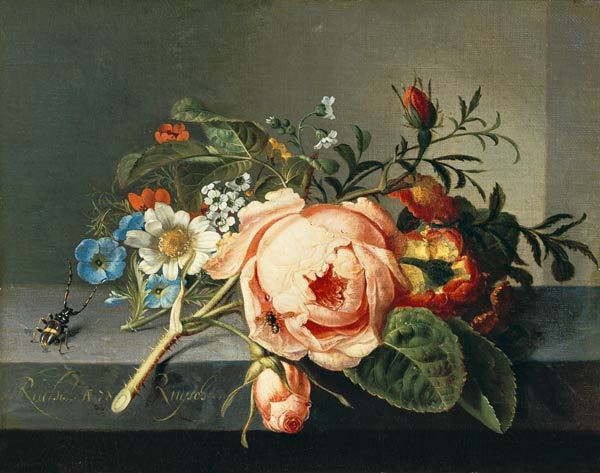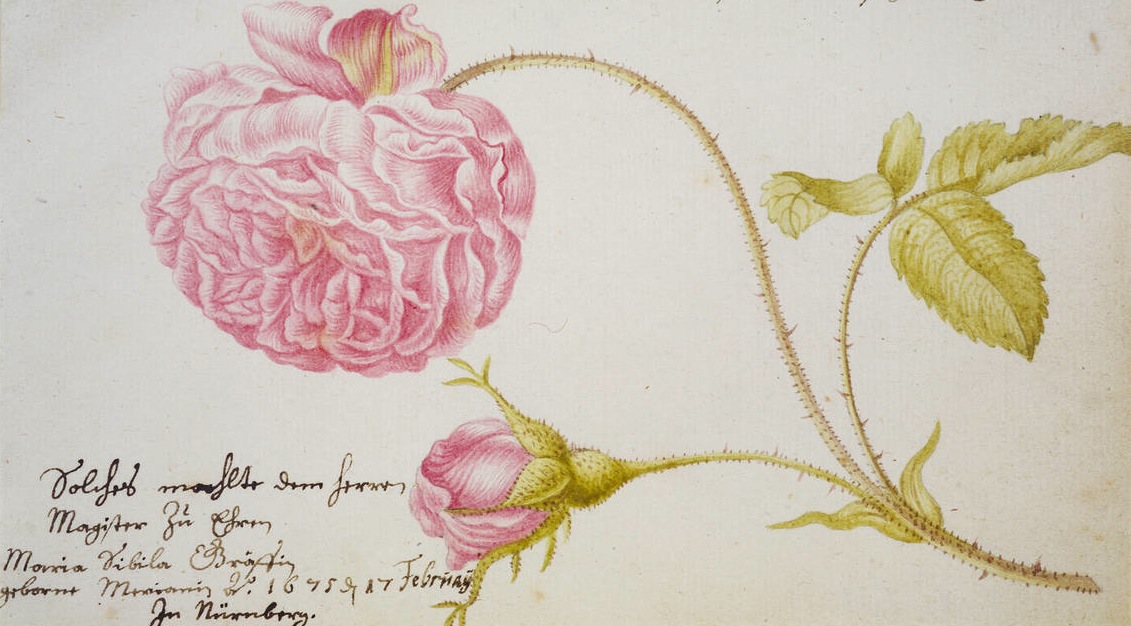Rose Branch with Beetle and Bee

Rachel Ruysch, Rose Branch with Beetle and Bee, 1741. Oil on canvas, 20 x 24.5 cm. Basel, Kunstmuseum, inv. no. 1100.
The alluring scent of fresh roses overtakes the viewer’s nose. Soon after, the viewer hears the fait buzz of a bumblebee who transitions from hovering to gracefully landing on the rose’s soft pink petal. The sensual sabotage of Rachel Ruysch’s late eighteenth-century painting safeguards the viewer’s gaze and attention. On the far left of the composition, the black and gold beetle’s body generates upward motion and a diagonal line that propels the viewer into the mass of entangled flowers lying on a grey, stone table. The source of light that so brilliantly illuminates the flora of this painting remains unknown to the viewer. Nevertheless, Ruysch still achieves tremendously convincing modulations of shadow and light, which only enhances the subject’s realism. To be sure, the composition of Rose Branch with Beetle and Bee seems unconventional at first, with the flowers scattered about as if just placed on the stone ledge. In reality, however, its unconventional composition can be explained by the fact that it was painted toward the end of Ruysch’s career, when Ruysch was painting much simpler floral arrangements such as this one (note 1). This painting undoubtedly offers more than merely an aesthetically pleasing depiction of flowers. It offers the viewer an opportunity to not only cultivate a better understanding about flowers from the period, but also to explore and compare the different modes of floral still life paintings that emerged during the eighteenth century. To demonstrate her proficient knowledge and research efforts, Ruysch deliberately includes the tiny creatures in her floral works. To gain this level of knowledge and to paint the beetle with such immaculate detail, Ruysch must have consulted encyclopedic treatises published during the mid-seventeenth century, sources that specialized in the study of insects. In fact, she directly quotes the posture and positioning of many beetles found within these earlier compendiums, further reinforcing her intellectual and artistic expertise. Her widespread exposure to specimens of the natural world throughout her childhood also facilitated her ability to render these creatures with such impeccable precision. The viewer’s eye travels up a second diagonal line created by the thorny stem of the rose. Extending beyond the edge of the grey table, the stem abruptly enters the viewer’s space, along with supple, green leaves and even a second, smaller rose bud that has yet to fully bud open. Together, these extensions into the viewer’s space transform this painting from a flat, two-dimensional work into a three-dimensional piece that infiltrates the viewer’s space. Even so, the viewer cannot help but notice how even though the extension of the rose branch invites a closer look, its thorns aggressively threaten to prick anyone who attempts to analyze this tangled bouquet any further. Perhaps this thorny branch becomes a cautionary tool, a way to warn the viewer against hurriedly entering into this composition without first acquiring the necessary knowledge and context.
Notes:
note 1. Segal, Sam. "Willem Van Aelst and His School." The Magic of Things: Still-Life Painting, 1500-1800. Ostfildern: Hatje Cantz Verlag, 2008. 309-13. Print.
